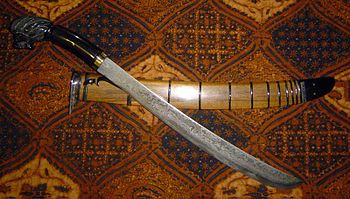Golok
| Golok | |
|---|---|

A traditional Indonesian golok.
|
|
| Type | Machete |
| Place of origin | Indonesian archipelago, Malay archipelago |
| Service history | |
| Used by | Pribumi |
| Specifications | |
| Length | 25-40cm |
|
|
|
| Blade type | Single edge, convex grind |
| Hilt type | Water buffalo horn, wood |
| Scabbard/sheath | Water buffalo horn, wood |
A golok is a cutting tool, similar to a machete, that comes in many variations and is found throughout the Indonesian archipelago. It is used as an agricultural tool as well as a weapon. The word golok (sometimes misspelled in English as "gollock") is of Indonesian origin but is also used in Malaysia and is known as gulok in the Philippines. In Malaysia the term is usually interchangeable with the longer and broader parang. In the Sundanese region of West Java it is known as bedog.
Sizes and weights vary, as does blade shape, but the typical length is 10–20 inches. Golok tend to be heavier and shorter than parang or common machetes, often being used for bush and branch cutting. Most traditional golok use a convex edge or an edgewise taper, where the blade is less likely to get stuck in green wood than flat edged machetes. The blade is heaviest in the centre and flows away in a curve to a sharp point at the tip.
Golok are traditionally made with a springy carbon steel blade of a softer temper than that of other large knives. This makes them easier to dress and sharpen in the field, although it also requires more frequent attention. Although many manufacturers produce factory-made golok, there are still handmade productions that are widely and actively made in Indonesia, such as in Cibatu village, Sukabumi Regency, West Java.
In Indonesia, the golok is often associated with the Betawi and neighboring Sundanese people. The Betawi recognize two types of golok; gablongan or bendo is the domestic tool used in the kitchen or field for agricultural purposes, and the golok simpenan or sorenam that is used for self-protection and traditionally always carried by Betawi men. The golok is a symbol of masculinity and bravery in Betawi culture. A jawara (local strongman or village champion) will always have a golok hung or tied around the waist at the hips. This custom, however, has ceased to exist since the 1970s, when authorities would apprehend those that carry the golok publicly and have it confiscated it in order to uphold security, law and order, and to reduce gang fighting.
...
Wikipedia
